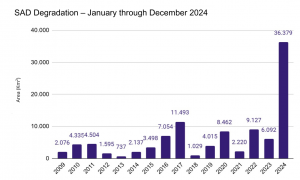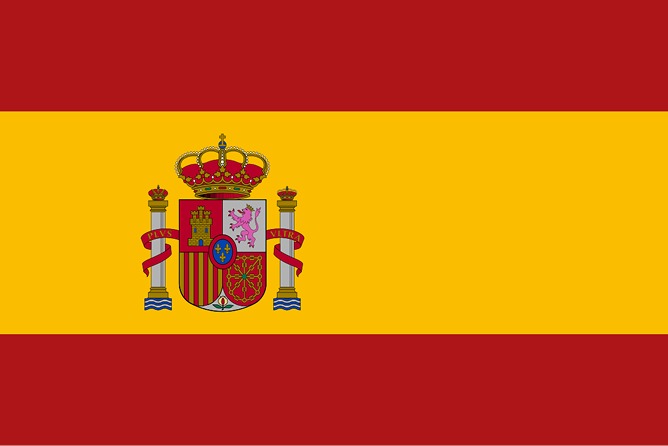We can't find the internet
Attempting to reconnect
Something went wrong!
Hang in there while we get back on track

The Amazon ends 2024 with a 7% drop in deforestation, but a 497% increase in degradation
24/01/25The degraded area increased due to burning, especially in August and September

In 2024, the Amazon rainforest had its second consecutive year of declining deforestation, after a sequence of five years with negative records of destruction. From January to December, 3,739 km² were cleared, 7% less than in the same period in 2023, when devastation reached 4,030 km².
Compared to 2022, when the area cleared in the Amazon was 10,362 km² from January to December, the area cleared in 2024 was 65% smaller. Despite the significant drop, the balance of forest lost last year represents more than a thousand soccer pitches a day. The data comes from the Deforestation Alert System (SAD) of the Imazon research institute, which has been monitoring the region using satellite images since 2008.
!

Degradation in 2024 was the highest in the past 15 years, since 2009, when Imazon began monitoring this forest damage. Until then, the negative record was set in 2017, when 11,493km² were degraded. “This significant increase in the degraded area of the Amazon was due to the increase in fires, especially in August and September. In those two months, degradation grew by more than 1,000%,” says Larissa Amorim, a researcher at Imazon.
Carlos also points out that 2024 was a year of extreme drought in the region, which generates water stress and increases the forest’s vulnerability to fires. “There were two consecutive years of extreme drought in the Amazon, which even led to fires in the region’s wetlands. We hope this pattern doesn’t become the new normal. Carbon emissions from forest degradation associated with fires in 2024 exceeded emissions from deforestation,” warns the scientist.

Like deforestation, degradation also decreased in December after six consecutive months of increase. In the last month of the year, some 628km² were degraded, 40% less than in 2023: 1,050km². Despite the drop, the area affected by environmental damage in December last year was the second largest since 2009.
At the beginning of 2025, according to Larissa, degradation is expected to decrease. “Because of the rainy season in the Amazon, the forest areas affected by both deforestation and degradation are historically smaller in the first months of the year,” explains the researcher
Pará also led in degradation
Among the states, the largest degraded area last year was recorded in Pará: 17,195km². This was 421% greater than in 2023. Seven of the 10 municipalities that most degraded the Amazon last year are located in Pará: São Félix do Xingu (5,298km²), Ourilândia do Norte (1,937km²), Altamira (1,793km²), Novo Progresso (1,593km²), Cumaru do Norte (1,083km²), Itaituba (857km²) and Parauapebas (753km²).
In addition, the indigenous land and conservation unit that were the most degraded in 2024 are also located in Pará. The Kayapó territory, with 4,928km² degraded, and the APA Triunfo do Xingu, with 1,426km².
The second state to degrade the Amazon the most in 2024 was Mato Grosso, with 9,333km², a 767% increase over the previous year. Amazonas State ranked third, with 3,000km² affected, 291% more than in 2023.
| State | Degradation from January to December 2023 (km²) | Degradation from January to December 2024 (km²) | Variation |
|---|---|---|---|
| Pará | 3,298 | 17,195 | 421% |
| Mato Grosso | 1,076 | 9,333 | 767% |
| Amazonas | 767 | 3,000 | 291% |
| Rondônia | 217 | 2,861 | 1,218% |
| Roraima | 16 | 2,824 | 17,550% |
| Maranhão | 294 | 627 | 113% |
| Tocantins | 356 | 321 | -10% |
| Acre | 44 | 184 | 318% |
| Amapá | 24 | 34 | 42% |
See December figures here (in Portuguese)
Click here to access all the deforestation and degradation bulletins (in Portuguese)
Learn more about SAD here (in Portuguese)
 PT
PT
 ES
ES
 EN
EN

